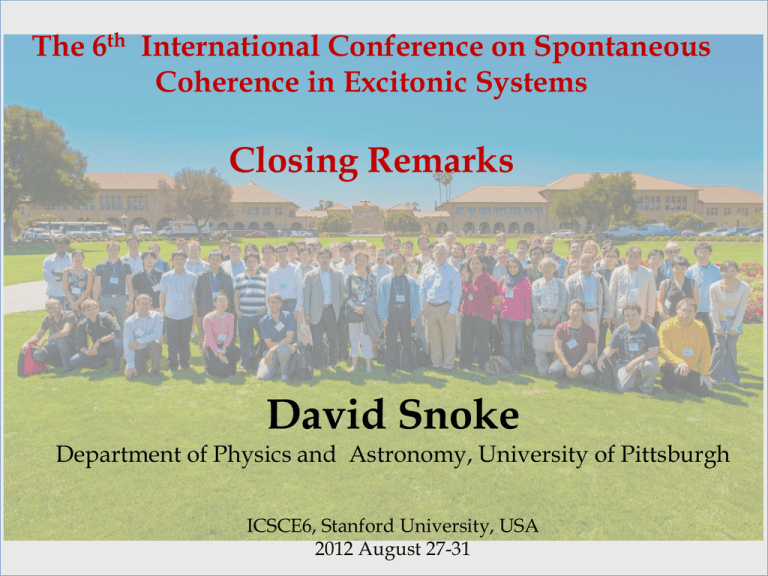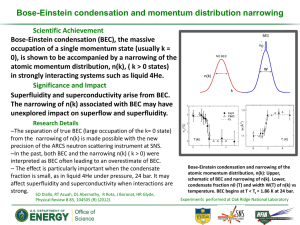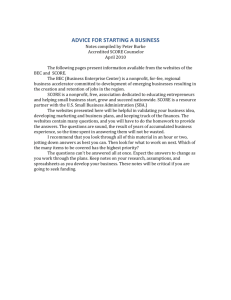David Snoke Closing Remarks The 6
advertisement

The 6th International Conference on Spontaneous Coherence in Excitonic Systems Closing Remarks David Snoke Department of Physics and Astronomy, University of Pittsburgh ICSCE6, Stanford University, USA 2012 August 27-31 Bloch sphere picture standard laser with inversion spontaneous symmetry breaking gives exact phase of oscillation See D.W. Snoke, “Polariton Condensation and Lasing,” in Exciton Polaritons in Microcavities, (Springer Series in Solid State Sciences 172, V. Timofeev and D. Sanvitto, eds., (Springer, 2012). (arXiv:1205.5756) Bloch sphere picture Excitonic condensate coherent oscillation without inversion See D.W. Snoke, “Polariton Condensation and Lasing,” in Exciton Polaritons in Microcavities, (Springer Series in Solid State Sciences 172, V. Timofeev and D. Sanvitto, eds., (Springer, 2012). (arXiv:1205.5756) Amplified stimulated emission (ASE) fast dephasing scales with size of system, with critical size Lasing Requires inversion. Spontaneous symmetry breaking gives amplification of phase coherent fluctuation Superfluorescence (SF) Same as lasing, but without mirrors or continuous pump: a spontaneous coherent pulse following inversion (after time delay) Superradiance (SR) Same mechanism as SF, but starts with coherent driving pulse. Maps to classical case of coupled antennas. Can still have spontaneous symmetry breaking in emission direction. Exciton condensation No inversion: amplification of phase coherent fluctuation through pair-pair interaction (“stimulated scattering”) Photon condensation (Weitz et al.) Only possible through effective photon-phonon interaction via incoherent medium inversion? coherent medium? spontaneous phase? amplified stimulated emission (ASE) yes no no superfluorescence yes yes yes superradiance yes yes no lasing yes yes yes dielectric medium no yes no excitonic BEC no yes yes photon BEC no no yes Terminology debates “condensation but not BEC” is silly. BEC occurs when a macroscopic fraction of all particles enter the ground quantum state (in some reference frame; moving condensate is allowed) -that ground state often includes a component with off-diagonal longrange order (ODLRO). Long-range = extensive with system size -but not always, if ground state is not extensive with system (e.g. a trap) more controversial: BEC occurs spontaneously via thermalization -requires examination of excited states (should have a thermal tail) -“perfect” equilibrium not required and never happens anyway -“quasiequilibrium” = subset of system can be well described by equilibrium e.g. electron or exciton gas not in equilibrium with lattice -system must have a mechanism by which the excited states and ground state approach equilibrium By this definition, BCS is a type of BEC (and so is bilayer quantum Hall condensate) and so are trapped atom BEC and helium-4 and helium-3 By this definition, lasing is not BEC, and OPO is not BEC - but laser is an example of spontaneous coherence which is a special case of spontaneous symmetry breaking (SSB) -spontaneous coherence is SSB with a complex (two-component) order parameter i.e. amplitude and phase BEC is a special case of spontaneous coherence By this definition, polariton and photon BEC (and magnon BEC) can be BEC -may not always be BEC: sometimes spontaneous coherence far from equilibrium may be occurring (“polariton laser”) Variations: “Quasicondensate” = macroscopic fraction in tiny region of state space near ground state but not exactly one state (dephased, or fluctuating, BEC) - can occur in equilibrium, e.g. 2D BKT, possibly attractive 3D Bose gas - can occur as transitory stage in path to equilibrium -2D system can become quasicondensate, not true BEC, in infinite system, but large, trapped 2D system can be true BEC. - no significant difference between 2D and 3D trapped BEC - in practice quasicondensate may be hard to tell from full BEC (e.g. superfluid helium on a surface) “Nonequilibrium BEC” = not far from equilibrium, but nonequilibrium effects large enough to measure differences from equilibrium solution -probably greatest contribution of polariton community to fundamental physics so far: many equilibrium BEC phenomena preserved even as system deviates significantly from equilibrium “Bose glass” = locally BEC but strong disorder prevents long-range phase coherence - also interesting to look at crossover to full BEC (e.g. phase locking seen in polaritons) Superfluidity Not the same as BEC. Can have ~100% superfluid and 0% BEC (e.g. BKT superfluid in 2D) and 100% BEC and 0% superfluid (e.g. ideal Bose gas) But they are related: stimulated scattering makes it strongly unfavorable for particles to act independently as is required for drag. Need at least a quasicondensate for superfluidity, and ideal BEC may be viewed as superfluid with zero critical velocity. Superfluidity is defined by transport measurements: flow without drag. Two-fluid model: only normal part feels drag. “Just” classical waves Why are there classical waves at all, if we live in a quantum world? A macroscopic Fock state (definite number of particles, indeterminate phase) is a physically possible state A water wave = macrocopic number of bosons in single k-state Fock state = superposition of different phases, definite amplitude Snoke, Liu, and Girvin, Annals of Physics 327, 1825 (2012) infinite homogeneous Bose gas in-flow: negligible at low density (~N2) out-flow: negative out-scattering normally leads to “dephasing” but for highly occupied states (near k=0) “enphasing” occurs. True for Planck as well as BEC systems Our normal experience of superpositon of low-frequency waves with definite phase (= “classical wave approximation”) arises from this. Planck distribution occupation number f(E) classical regime normally no average coherence, no single state dominates unless BEC f(E)D(E) E/kBT macroscopic coherent classical wave can arise via non-spontaneous symmetry breaking “driven condensate”? = classical wave (e.g. bell hit by hammer) E/kBT Progress 1. Room temperature condensate very doable already reasonable claims in polariton systems; RT in weak coupling with photons; also magnons 2. Equilibrium condensate of excitonic systems doable permanent bilayer (BCS-like); long-lifetime polaritons 3. Long-range transport of polaritons doable continuously pumped solitons, long-lifetime polaritons, wires 4. Crossovers interesting: BEC/BCS, PBEC/laser, strong coupling/weak coupling, equilibrium/nonequilibrium/far-from-equilibrium 5. Lots of ways to control and manipulate polaritons stress, laser AC Stark, laser exciton cloud, surface patterning, acoustic lattices... M. Gonokami T. Ogawa The University of Tokyo Osaka University








